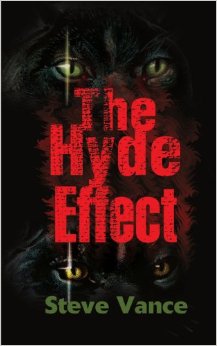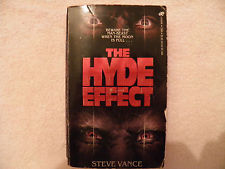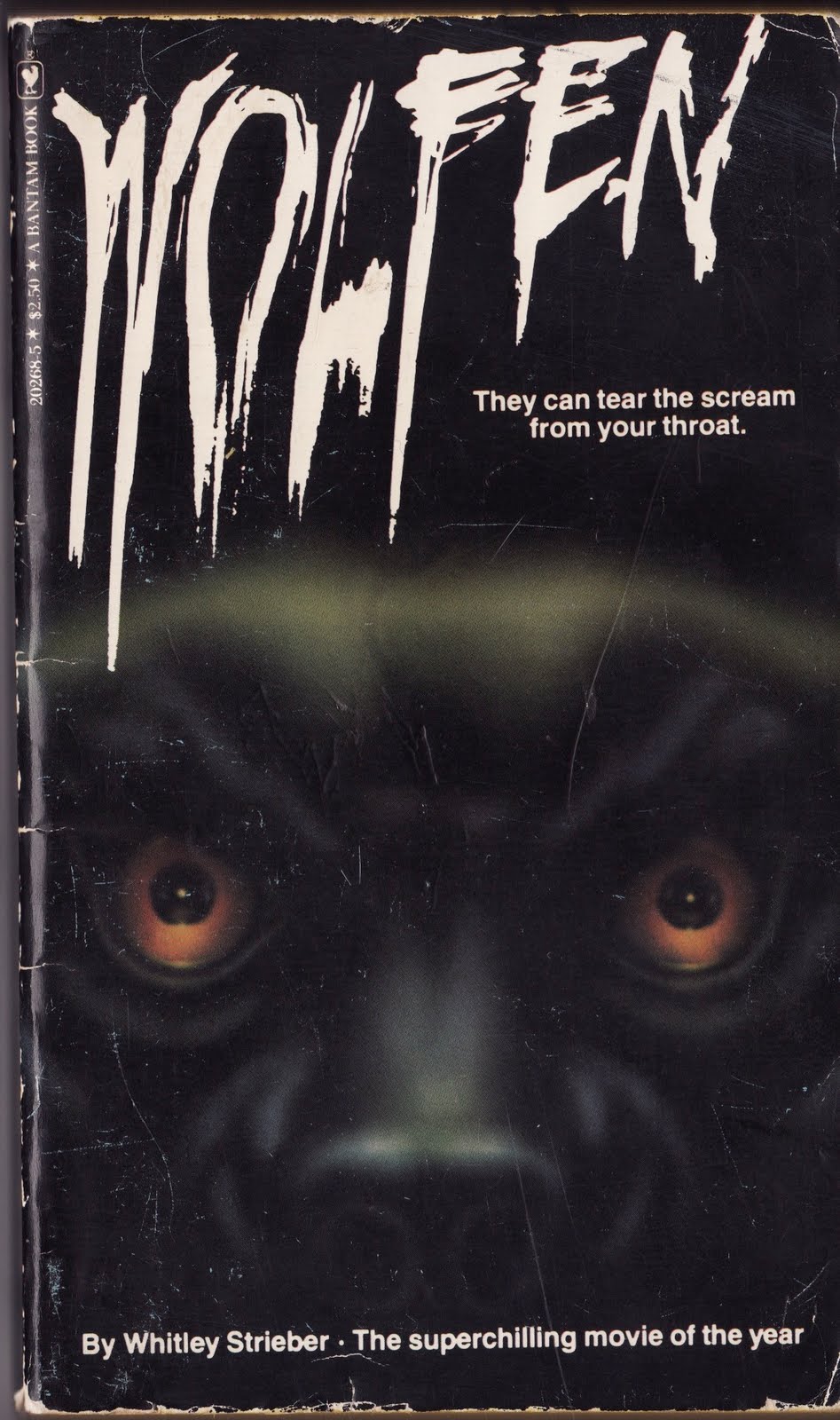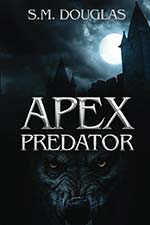Hello horror fans and aspiring authors – do I have an unexpected treat for you! In honor of last year’s Halloween I posted what I regard as the two greatest werewolf transformation scenes of all time. That got me thinking about the film backing one of those scenes: The Howling. That led me to pick up the book of the same name for a pre-Halloween revisit of an old favorite. From there I ended up reviewing and ranking my three all-time favorite werewolf books: The Howling, The Wolfen, and The Hyde Effect. For those of you not interested in reading the reviews I ended up picking The Hyde Effect as my champion. It narrowly edged out The Wolfen, with The Howling coming in third. I thought that would be the end of it. But then I got an email from the author of The Hyde Effect, the one and only Steve Vance.
Mr. Vance will be the first to admit he isn’t into blogging or social media, but somebody read my review and sent it on to him. From there he reached out to offer his modest thanks. I was thrilled to hear from one of my favorite horror writers. In turn I inquired as to whether he would like to do an interview, and here we are folks! So for all of you horror junkies, aspiring authors/bloggers/creative types please strap yourself in for an exclusive conversation with the down to earth but informative Mr. Steve Vance:
Random Pop Culture: Hello Steve. Please tell us something about yourself, where you’re based, and how you came to be a writer.
Steve Vance: I was born and raised in the state of Georgia (7/13/52). I now live outside of Dalton, in the northwestern corner, some thirty miles south of Chattanooga, Tenn. I suppose I’ve actually been a “writer” since before I could write. I was always a teller of tall tales and can even remember sitting in my Granddaddy’s lap and reciting to him my adventures as a cowboy who had once had his head chopped off by “bad guys” before it was sewn back on again. One of the most magical moments of my early life was when I was introduced to the public library and informed that plenty of other people were just as interested in making up stories as I had always been.
Random Pop Culture: Why horror, and have you considered other genres?
Steve Vance: Actually, my initial forays into writing were in the science fiction genre. My first published novel (PLANET OF THE GAWFS, Leisure, 1978) was a trans-planetary space opera, as were the following pair of THE REALITY WEAVERS (Laura Books, 1979) and ALL THE SHATTERED WORLDS (Manor Books, 1979), though these latter two strayed significantly into the realm of science fantasy. The horror field called to me more and more in my personal interests, and I began to lean in that direction in short fiction. THE HYBRID (Leisure, 1981) was my first “all-out” horror novel. THE HYDE EFFECT (Leisure, 1986) sort of completed the transition. Not being particularly bright in the field of science (among others), I find horror much more freeing.
Random Pop Culture: What are your favorite works to-date? Have you ever written under a pseudonym?
Steve Vance: I’ve never actually thought about a favorite work. THE HYDE EFFECT seems to have connected with the readers the best (though SPOOK, Soho Press, 1990, remains my most widely embraced work in the mainstream world) and stands up well after repeated readings according to online reviewers. I have a fondness for WALPURGIS NIGHT (Silk Label Books, 2002), as well, though it passed rather unnoticed. I’ve published one novel under a company pseudonym — and I’m not at liberty to identify it — and a number of short stories. Several of the stories are available online in narrated form.
Random Pop Culture: Have you had any rejections? If so, how do you deal with them?
Steve Vance: Any rejections? Enough that I gave up counting a long time ago. I won’t lie: they hurt. But you just have to let them go. A mean-spirited part of me enjoys recalling that my “home publisher” Leisure passed on SPOOK rather blithely and then aggressively begged to handle the soft cover publishing of the book once it had appeared in hardcover at Soho Press.
Random Pop Culture: Have you won or been shortlisted in any competitions?
Steve Vance: Nope. I’ve never entered any competitions. I know that the cover art for THE ABYSS (Leisure, 1989) won a second place award in some competition just after publication, though I don’t have any details.
Random Pop Culture: Do you read eBooks or is it paper all the way?
Steve Vance: I’m a paper fan (I really love owning something that entertains me), but I’m not actually biased against eBooks. I’m looking into the field now, in fact.
Random Pop Culture: How much of the marketing do you do for your published works or indeed for yourself as a ‘brand’?
Steve Vance: Almost none. I’ve never actually been introduced to the marketing part of the business, though I have done a (very) few television and radio interviews and a few book signings. I believe that Silver Leaf Books, who will be publishing THE TIME FOUNT PROJECT this year (sci fi/adventure/horror), will expect some self-marketing efforts from me. However, with the physical appearance of a fat little hillbilly and the voice of a twelve year old pot smoker, I’m not exactly in demand personally.
Random Pop Culture: Do you have a favorite of your books or characters? If The Hyde Effect were made into a film, who would you have as the leading actor/s?
Steve Vance: As stated above, I don’t have any real favorites. Well . . . maybe HYDE. I’ve never given any thought to who might take the parts of the novel in a film. Blake Corbett — who didn’t even appear in the short story version of HYDE, which was published in Tesseract Science Fiction, 1979 — was pretty much based on yours truly, though I harbor no illusions about acting, believe me. Nick Grundel was somewhat modeled on the young Richard Dreyfuss of JAWS. Nick wasn’t in the original short story, either.
Random Pop Culture: Did you have any say in the titles / covers of your book(s)? How important do you think they are?
Steve Vance: One novel had a slight title change made by the editors — REVOLT OF THE GAWFS became PLANET OF THE GAWFS –, while two others underwent complete retitling when I KNOW THE WORDS became THE ABYSS (Leisure, 1989) and THE HIDDEN LIFE morphed into SPOOK. The only input I’ve had into cover art was with WALPURGIS NIGHT, when (after being asked) I suggested the scene of the unfortunate skeptic being blasted through the roof of the exploding building. Silver Leaf wants me to arrange the cover art for THE TIME FOUNT PROJECT, but I have absolutely no idea how to go about it. I really should get to work on that.
Random Pop Culture: What are you working on at the moment / next? Any future werewolf books in the works?
Steve Vance: I’ve been churning out a few short stories for the last couple of months and don’t have a novel in mind at the moment. SHAPES (Leisure, 1990) was a direct sequel to HYDE, and a number of online reviews have mentioned that the reviewers would enjoy another entry into the “series,” but as I said, I haven’t given it much consideration, yet. I’d certainly like to work on more novels.
Random Pop Culture: Who are your favorite horror authors? What are your favorite horror movies?
Steve Vance: I’ve always enjoyed Richard Matheson’s work, and Charles Beaumont and Fredric Brown produced some delightfully twisted material. My horror movie favorites tend to drift into science fiction territory. I believe that THE THING (FROM ANOTHER WORLD) and THE BEAST FROM 20,000 FATHOMS are two of America’s best films of any genre, and each produced screaming nightmares in me during my younger movie-watching days. Unlike many in my age bracket, I tend to enjoy “found footage” movies, and CLOVERFIELD and CHRONICLE are wonderful recent examples of that form of narrative. VAMPYR and the original NIGHT OF THE LIVING DEAD have retained their impact for me over the years. In the anthology area, it’s difficult to top DEAD OF NIGHT. CIEN GRITOS DE TERROR is a terrific Spanish-language film that seems to get very little affection in the English-speaking world these days.
Random Pop Culture: What do you see as the essential elements of a good horror book?
Steve Vance: I feel that no matter what the surrounding actions are, there should be some discernable humanity in the characters who are experiencing that action, something that the reader can connect with whether the character is ostensibly “good” or “bad.” If the people who are acting or being acted upon are just ciphers who are set up simply so they can be knocked down, who cares? It’s certainly not an original idea with me, but it remains a good one, I think. Plus, as King has said many times, there comes a point when you have to show the monster. Some of the most memorable moments in horror literature have come from intimation, but over the course of a novel that intimation must prove itself in a more concrete fashion. That’s just my opinion, of course.
Random Pop Culture: Do you manage to write every day? Do you ever suffer from writer’s block?
Steve Vance: If I have an idea that’s working out, evolving, I can hardly wait to start hitting the keys every day. If the theme isn’t managing to separate itself from a thousand other stories that folks have done before and better, just opening the file can be a monumental task. I should write much more than I do, and that unprofessional attitude has proven quite detrimental over the years.
Random Pop Culture: Do you plot your stories or do you just get an idea and run with it?
Steve Vance: It varies. Usually, maybe seventy per cent of the time, a good idea really does drive the process; I may not even know how the work will end until it gets there. Less frequently, the ending has written itself in ones mind before the first word is typed, and the challenge is to get to that ending in some entertaining way. HYDE represents both points of view: as a short story, it practically wrote itself because I had the foundation that I wanted to explore, an ancient, very violent force of nature trapped in a sterile, very modern location. A werewolf in a closed hospital environment. When it came to expanding the story into a novel, I realized that simply doubling or tripling the time spend in the hospital would get repetitive and boring, so I introduced three more central characters in Blake, Nick, and Meg (only Douglas appeared in the short story). Then I set about detailing how these people came to accept that, first, there was an actual werewolf on a killing rampage in their modern world, and, second, that they would have to find him and stop him with little or no help from a disbelieving society. For some readers, this worked. Others complained that it took too much time to get to the “meat” of the material, in the hospital.
Random Pop Culture: Do you have a method for creating your characters, their names and what do you think makes them believable?
Steve Vance: No method as such. A lot of the characters, good and bad, are just extensions of myself. Sometimes they seem to create themselves in response to the fictional environment. Occasionally, an effective character from some other novel or film or real life experience can bull his or her way into the story. I don’t spend a lot of time on name selection. A name can just sound right to me (as a boxing fanatic, I wanted to use the name “Corbett,” after oldtime heavyweight champ James J. Corbett, for the lead character in HYDE, for example), or I might pick up a copy of Leonard Maltin’s film reviews and scan through until a “correct”-sounding first and last name wave at me.
Random Pop Culture: Do you write any non-fiction or short stories?
Steve Vance: I’ve published, I suppose, fifty or so short stories since 1977 (when my first, “The Two-Edged Sword,” debuted in Amateur Boxing without any previous notification from the editor — literally, I simply picked up an issue in the bookstore and saw my name in the table of contents). They’ve appeared in periodicals such as Asimov’s Science Fiction, Unearth, Dark Fantasy, Cemetery Dance Magazine, Brutarian, Cicada and its companion Cricket (best paying markets by far), FarThing, Paradox, and The Magazine of Fantasy & Science Fiction. The only non-fiction I’ve published were a couple of articles in boxing monthlies and a short series of film reviews in FilmFax back in the late Nineties. That was a lot of fun.
Random Pop Culture: Do you do a lot of editing or do you find that as time goes on your writing is more fully-formed?
Steve Vance: I try to edit at least once. With modern technology (I.e., computers) editing is practically enjoyable, but even when I was scribbling words in pencil on lined paper, I would force myself to re-read at least once and correct all of the mistakes a careless writer will make without thinking. Even today, I am startled by how many of these mistakes made the “final cut” in HYDE and THE REALITY WEAVERS and many of those other early efforts.
Random Pop Culture: Do you have to do much research?
Steve Vance: Not too much. With horror, unlike science fiction, the writer can pretty much manipulate “reality” to suit the story, anyway. Generally, I enjoy what research I do engage in, in any case.
Random Pop Culture: What point of view do you find most to your liking: first person or third person? Have you ever tried second person?
Steve Vance: Third person seems to work best for me. PLANET OF THE GAWFS was in first person, and it worked well for the casually conceited main character, but I try to give some portion of the overall story to each primary character, and that’s tough to do in first person. H.G. Wells was able to portion out perspective to other characters while remaining in first person in works such as WAR OF THE WORLDS, but I’m no H.G. Wells. A number of my short stories do take place in first person, but that’s a lot easier to pull off in such confined spaces. Second person can give a definitely creepy vibe to a story (never read a novel in second), but I haven’t tried it.
Random Pop Culture: Do you have pieces of work that you think will never see light of day?
Steve Vance: Oh yeah. A number of them from years back, including complete novels. Times change, other writers come out with the same idea before you. I had a short story called “The Deadly Defenseless” that I marketed unsuccessfully in 1975 which basically was DIE HARD before DIE HARD (Christmas shopper is trapped within a huge building during a takeover by a “terrorist group” who turn out to be there for the money, and said shopper takes them down one at a time), so I’m pretty sure that one will rest only in my forgotten files. Just because they weren’t published doesn’t mean you fail remember them, however.
Random Pop Culture: What’s your favorite / least favorite aspect of your writing life? Has anything surprised you?
Steve Vance: It’s a silly answer, of course, but my favorite part is the moment when everything “clicks,” all of the ideas that have been swimming aimlessly around the central structure find their various points of connection and you realize, “Hey, this is going to work!” Least favorite is probably the rejection that contains absolutely no reason for being a rejection, nothing beyond a “Doesn’t work for us; good luck elsewhere.” Was it badly written? Too much like too many other stories/novels? Plain boring? I know that being an editor can be difficult, but it’s your job, right? Give us a little indication as to what we’ve done wrong, won’t you? What continually surprises me is how anything that’s published never really vanishes completely. I’ve seen short stories of mine that appeared in semi-pro magazines in the Seventies listed for sale on sites such as ABE (Advanced Book Exchange). I was quite shocked when HYDE turned up on your list of (ahem) great werewolf novels, believe me. Surprising and gratifying.
Random Pop Culture: What advice would you give aspiring writers?
Steve Vance: Don’t be afraid to see where your ideas will take you. They may be inspired by the works of others, but they won’t be mere echoes if you allow your imagination to run with them. Rejections hurt — every writer knows this –, and quite often there will be something to learn from each rejection. Especially if the rejection slip contains actual comments rather than simple rote dismissals (which is becoming increasingly rare these days — see above). But you also should remember that in most cases the rejection comes from a single editor. He or she didn’t care for your work; that doesn’t mean the next one won’t “get” what you’re endeavoring to say.
Random Pop Culture: Where did your ideas for The Hyde Effect come from? What prompted you to write a werewolf book?
Steve Vance: To be honest, the idea for HYDE originated in a late night television viewing of the film version of Michael Crichton’s THE TERMINAL MAN. I’m not comparing the novels, but watching actor George Segal mutate from an ordinary, modern human being into an uncontrollable killing machine in the (relatively) sterile and scientific surroundings of a hospital struck me as inspired. I wondered how matters would play out if a real “old school” monster from olden days were to be locked within a high tech facility along with a hundred or so unfortunate men and women unable to escape his bloodlust. Which old-fashioned monster best fits the bill as a mindless, ravaging nightmare? The werewolf, of course. I wrote a short story version quickly (I’m not certain where the title came from now — it simply was a perfect fit) and sold it in 1979 to the first market I tried, the now defunct but not forgotten Tesseract Science Fiction. There was some good response from it, and when I was casting about for an idea for a longer work some five years later, I decided to try expanding the short story to novel length. This involved the new first half detailing the creature’s months-long rampage and capture, which, in turn, necessitated adding three more main characters in Blake, Meg, and Nick.
Random Pop Culture: What do you think of the recent explosion in supernatural themed movies/shows like True Blood, Walking Dead, American Horror Story, and so on…Why now and not thirty years ago?
Steve Vance: I feel that the introduction of cable television and its freedom from standard network censoring has contributed immensely to the current popularity of horror and the supernatural. Can you imagine any of those television programs appearing on NBC/CBS/ABC in the Sixties or Seventies? This era is sort of the “revenge” of the old EC horror magazines from the early Fifties, which were driven out of publication by government interference, you’ll recall. American Horror Story especially reflects that EC psyche. Also powerfully influential is social messaging, in which fans of what once was a denigrated and marginalized arm of the entertainment world (horror — and to some extent sci-fi) can interact with one another with no concessions to the smug “guardians” of modern entertainment. “Monster magazines” of my youth, such as Famous Monsters of Filmland, Castle of Frankenstein, and Monster World were wonderful, but they also were poorly-funded, produced by very small publishing houses, and often difficult to find in “respectable” bookstores and news stands. Nowadays, go on Google and type in “horror sites,” and watch as several dozen responses pop up in seconds. Horror fans are now a much less isolated community than before. With this exploding fan base came larger budgets for more widely-targeted films. Money talks. The teen/young adult film adaptations seem to be coming more to the front in films recently, but horror is now far too established as a money-making genre to ever fade back into the “grind house” times, I think.
Random Pop Culture: Are you involved in anything else writing-related other than actual writing or marketing of your writing?
Steve Vance: Nope. I once hoped to someday start up a magazine dealing exclusively with first efforts from beginning writers, but since I lack the expertise on both the artistic and financial sides of that issue to make such an undertaking viable, it never went beyond the wishing stage.
Random Pop Culture: What do you do when you’re not writing? Any hobbies or party tricks? 
Steve Vance: I’m quite boring as a person, I’m afraid. I have a great extended family who mean the world to me and with whom I interact regularly. I love movies and have been the biggest boxing nut you could imagine for the past forty-five years or so, and those things take up most of my spare time. I’ve lived a very lucky life.
Random Pop Culture: Are there any writing-related websites and/or books that you find useful?
Steve Vance: The Locus Magazine site remains an excellent source for freelancers. I used to await its arrival in the pre-Internet snail mail days with something like a deep hunger. The site I most regularly visit nowadays is Ralan Conley’s writers’ resource, which is an absolutely first class location that’s updated practically everyday. Those two are invaluable.
Random Pop Culture: Are you on any forums or networking sites? If so, how valuable do you find them?
Steve Vance: Not really. I’m something of an aged cliché, I suppose, stuck (by choice) out here in the North Georgia woods. I have been on Facebook for about a year now (I joined because a boxing discussion group I belong to made the move from Yahoo), but I don’t have a personal page or anything. I guess I should. I shared your unexpectedly complimentary article about HYDE on that site, and it garnered a good deal of attention. (Thanks again!)
Random Pop Culture: What do you think the future holds for a writer?
Steve Vance: The same as it ever has, I suppose: lots of solitary work, lots of expectations, lots of rejection, and a few blazingly wonderful moments of success. Oh, and plenty of pleasant inquiries of, “What are you working on now?”
Random Pop Culture: Where can we find out about you and your work?
Steve Vance: I’m told that I should institute a Facebook page, but I haven’t decided whether to undertake such a step, yet. My next novel, THE TIME FOUNT PROJECT, will be appearing sometime in ‘15 from Silver Leaf Books.
And I’ve just sold a short story called “The Long Night” to the children’s fiction magazine Cricket, which will probably show up a bit later in the year.
Random Pop Culture: Is there anything else you’d like to mention?
Steve Vance: Just a reminder to those considering this line of work that seeing your name on a cover makes it worth all of the work and uncertainty.
Random Pop Culture: Steve was also gracious enough to provide a short excerpt from from The Hyde Effect’s Chapter 12: A Wildfire of the Soul:
An exceptionally loud report exploded above the screams, causing Morgan to wince. Cummings was suddenly falling backwards while emitting a mad howl of pain and surprise. Instinctively, Doug, who had seen the effects of bullets on bodies before, thought, He’s dead, it’s over. But this mixed relief and loss was premature.
Rolling on the floor and jabbing his feet into the air in agony, the metamorphosed man jerked to his right shoulder, flipped sharply, and was abruptly standing again. He crouched and roared defiantly and displayed no sign of injury other than a splash of red in the fur of his back where the bullet had exited.
“For the love of god, he’s healed!” a doctor in the gallery stated in awed recognition.
The policeman fired again and was joined by his three fellow officers in the assault, so that the air was quickly filled with the flare and thunder of their guns . . . .
Even as the police emptied their guns into him, his body was accepting the bullets, in a fashion absorbing them, and expelling the metal through its own momentum while repairing whatever damage had been caused by the passage faster than the officers could pull their triggers. Even the most vicious wounds were knitting in seconds, and the incredible symbiotic activities of a human mind and the world’s most extraordinary disease gave irrefutable proof that invincibility in man had been approached.
Now let’s take a brief look at Steve’s upcoming and newest publication:
Set in 1990, just following the fall of the Soviet Union, THE TIME FOUNT PROJECT is an old-fashioned science fantasy/horror novel about a group of disparate young men and women who are called together by a university professor and informed that they share a common heritage with an ancient, almost mythic French hero . . . and that they have been blessed with the same nearly superhuman abilities as he. While they are cultivating these inherited properties, their paths also cross that of another group of people, these former Soviet agents who have discovered the strangest natural phenomenon on the planet in the Colorado mountains. There’s plenty of action, some mystery, and even a looming King Kong-like creature snatched from hundreds of thousands of years ago (and none to happy about it).
With that said I’d like to once again thank author Steve Vance for offering Random Pop Culture this exclusive and much appreciated interview.







Recent Comments